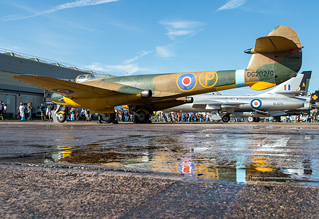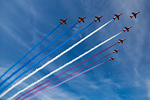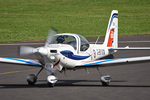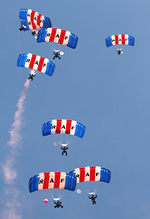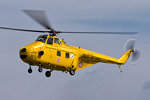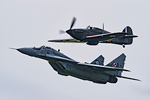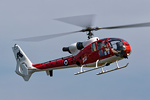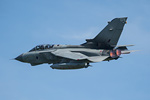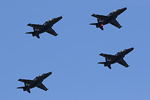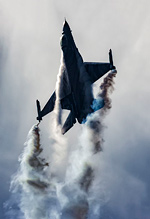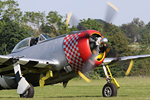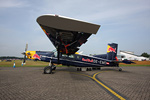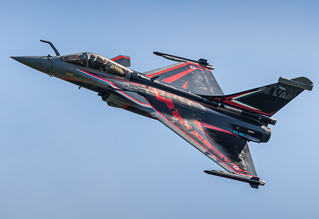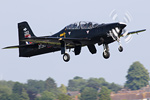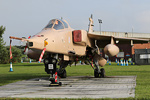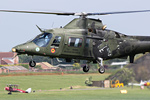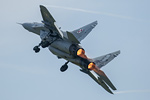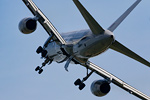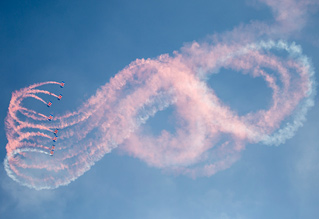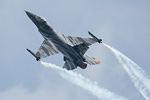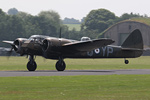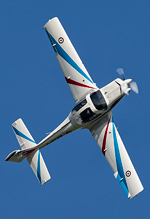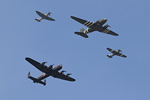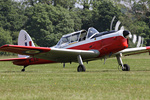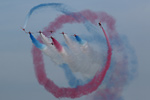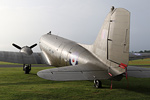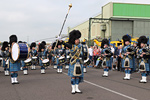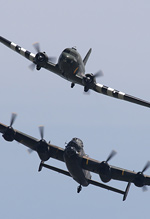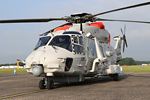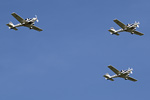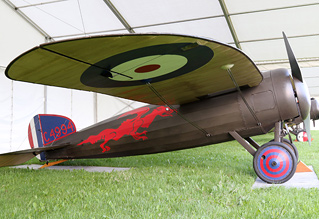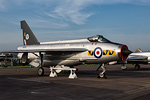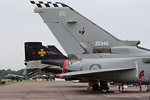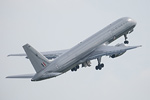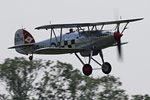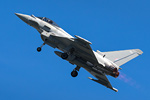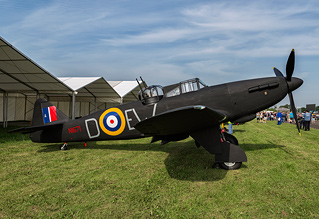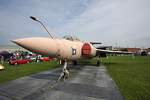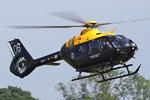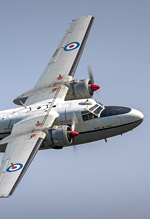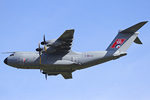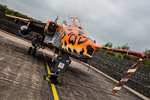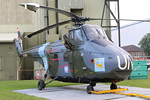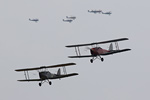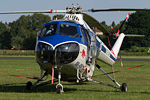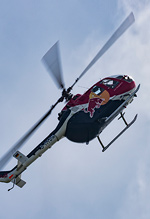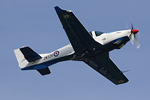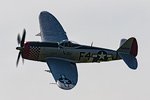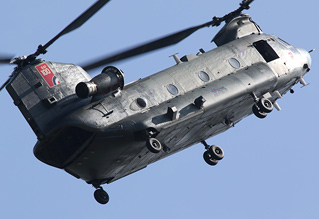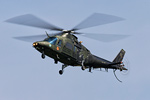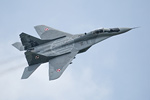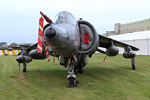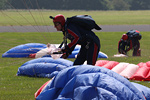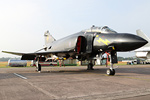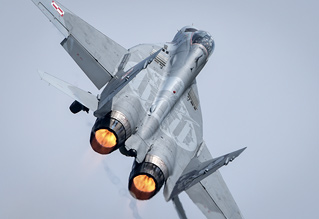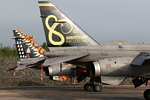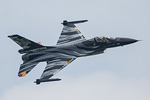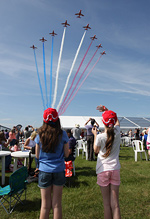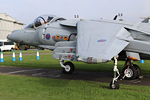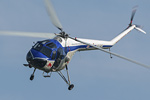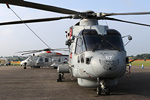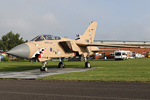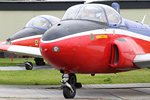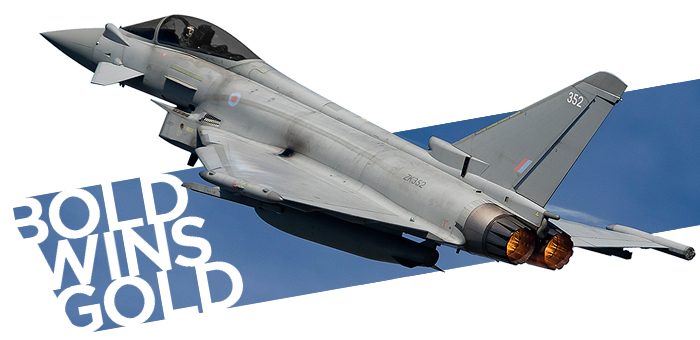
RAF Cosford Air Show
Sunday 10th June 2018
"Commemorate, Celebrate, Inspire". That's the official RAF100 strapline, and the RAF Cosford Air Show was the first full public physical manifestation of the celebration of the birthday of the world's first independent air force, and indeed, the only true Royal Air Force airshow left standing. With a sell-out crowd, and (for once) fair weather forecast, all eyes turned to the RAF Cosford Air Show to see whether the Royal Air Force could indeed deliver to the public an airshow worthy of note in this most historic of years.
reports from the RAF Cosford Air Show. Photography from the UK Airshow Review staff team.
The most used term to describe the RAF Cosford Air Show is that it is "unashamedly a family-friendly airshow". It's fair to say that this year broke that mould, not because this year's Air Show was not "family friendly" - au contraire, it was a sell-out crowd - but that the RAF Cosford Air Show team managed it without all the "seaside filler" that normally achieves much criticism from the more hardened enthusiasts. The build up to any airshow is almost as important as the event itself. We have seen countless times that some shows can live or die by their pre-show information, PR, and general hype-building. All of this creates a feel for a show which not only sells tickets, but generally results in people arriving on the day with their mind already half made up. The RAF Cosford Air Show this year was a "gold event" in the RAF's calendar for their RAF100 celebrations. As it should be, given that it is the only true RAF airshow left standing. Straight out of the blocks this year, the Air Show felt different, in a better way. Starting with the much revamped (and easier to read) website, changes to the standard Cosford by the numbers were afoot.
The RAF Cosford Air Show team themselves kept quiet about it prior to this year, but the 2018 Air Show has been long in the planning. It was the big one. We knew, from as far back as March last year that the team were planning a "very spectacular static display". That started with a bang generated by details of what would ultimately result in two of the stars of the static park being announced. Firstly, the RAF Museum's Boulton Paul Defiant was pencilled in; the last complete survivor of the type in the world. Transferred from the RAFM Hendon site to Cosford, the Boulton Paul outside and clutter free was a tantalising thought and set the tone for things to come.
Hot on the heels of the Defiant announcement, news came through that F-4 Phantom XV582, "Black Mike", one of the most significant of all UK Phantoms, had been transported to the site and would take pride of place in the static park really got tongues wagging. Stored at RAF Leuchars for many-a-year, with the closure of the RAF station, the future looked bleak for that most charismatic, and historic, of machines. Let no-one underestimate the scale of the current operation. Now owned by GJD Services, the machine was transported by road to RAF Cosford, eight months ahead of the Show. Whereupon the British Phantom Aviation Group (BPAG) lovingly restored, cleaned, and presented her. A similar story exists with Cornwall Aviation Heritage Centre's, previously stored and unassembled, English Electric Lightning, ZF580, which was reassembled and restored, again with GJD Services' involvement, into 74 Sqn colours and given serial XR768.
These acts, and other museum pieces roaded-in, were more than just simple de rigueur airshow participation. They were positive preservations of iconic slices of Royal Air Force history. At a time when cost/benefit analyses tend to put paid to such ambitious initiatives, the Air Show team, RAF Cosford, Cornwall Aviation Heritage Centre, GJD Services, the RAF Museum, and of course BPAG all deserve a huge amount of commendation for working together to realise such a project, and indeed, making a success of it. This shared passion and devotion is what airshows should be all about. And cookie cutters and cook books and corporate logos aside, it is what (at least in part) the RAF100 celebration should be all about, too. And in both respects, the RAF Cosford Air Show nailed it.
With such a strong start, the Air Show's build-up went from strength to strength, and that momentum seldom dried up. This was in part due to the approach of the RAF Cosford Air Show electing not to seek any non-RAF civilian participation this year, which ruled out a lot of the much-maligned "filler" acts. This didn't extend to foreign aircraft, though. In recent years there's been an uptick in foreign air arm participation at RAF Cosford Air Shows. The Italian RSV Tornado was star of last year's show, and this year, the boat was once again pushed out. Although it never made it to the show, participation from the Pakistan Air Force Hercules was extremely notable, as was the appropriate return of the Royal New Zealand Air Force to the West Midlands, this time flying their Boeing 757 display. Belgium returned with a two aircraft commitment of both A109 and F-16 displays, and the French Air Force were announced as returning after many years' absence, this time flying the immensely popular Dassault Rafale solo display. Other items announced also started to pique interest. The debut of the Flying Bulls', and world's only airworthy, Bristol Sycamore, appropriate in the RAF's 100th year, and their jaw-dropping Bo-105 display were acts that people did not want to miss.
It was, however, to be the Polish Air Force, that held the mantle for most anticipated. Their MiG-29, never having performed at RAF Cosford (though it did make the participation list in 2015 before cancelling) made it to its temporary base of RAF Shawbury, and rocked the airfield in a practice display using callsign "Smoker" in practices on Friday. It was this display, that one of what must surely be one of the top UK airshow moments of this year occurred. Prior to the MiG running in on slot, Anglia Aircraft Restorations' recently airworthy Hurricane G-ROBT (P2902) flew a commendable sequence, before disappearing into the distance, and bringing with it on its return the venerable Fulcrum. The formation of a brief single pass along Cosford's crowd line was made all the more appropriate with the MiG displaying on one of its tail fins the name of Merian Cooper, a member of Kościuszko's Squadron, 7th Escadrille, which in turn inspired the venerable namesake Polish Air Force 303 Sqn which flew Hurricanes, and fought during the Battle of Britain.
A Polish Air Force machine in formation with an RAF-marked Hurricane has been long, long overdue, and credit to the RAF Cosford Air Show for finally making it happen. The Royal Air Force of today would be very little without its rich and diverse culture of foreign pilots who filled its ranks. It would be utterly, insultingly even, wrong to celebrate RAF100 without heed being paid to the sacrifices made by other nationalities under the RAF badge, especially those made during the finest hour.
The flying display itself took on an interesting chronological approach, which lent some rhythm and continuity to the day, interrupted with foreign aircraft displays. The Great War Display Team and Tiger 9 Display Team were interspersed with the RAF Falcons opening the show, carrying the RAF100 baton no less, and the Belgian F-16 which brought the crowd's attention to the air in what would have otherwise been quite a sedate start. Working through the inter-War period, Duxford's immaculate Hawker Fury made its first public display at a venue away from Duxford since its restoration in 2012. It is a crying shame that this machine (and a lot of other Duxford-resident warbirds) is not seen more widely around the UK, and credit must be due for allowing those in the West Midlands the chance.
As stated, the flying would have been off to a rather quiet and woolly start had it not been for the foreign aircraft participation, but their addition allowed the chronological formula to work well, progressing from WWI types, up to the oft overlooked inter-war period, and onto the second world war with the aforementioned Hurricane, the always-superb Blenheim, and Peter Teichman of Hangar 11 flying his Spitfire, PL965. A special moment it was for both that man and that machine at this event. The Spitfire itself, following construction in Aldermaston, was based at RAF Cosford for a time during its service before moving to Belgium. It's always special to see that particular machine return to its first RAF base. As for Peter Teichman, ever a stalwart of the UK airshow circuit, including RAF Cosford, has announced that he will hang-up his spurs at the end of the 2018 season. His last appearance at RAF Cosford was typically excellent, full of graceful movements, and a few topsides to boot.
The Battle of Britain Memorial Flight in their much-anticipated "Trenchard Formation" turned up, as ever, from crowd-rear. In 2017, their "Thompson Formation" was both welcome and evocative. Trenchard, appropriate in this RAF centenary, felt doubly-so. How rare, and great, it was to see and hear the Flight's Dakota in formation with the usual trio of Lancaster, Spitfire and Hurricane.
However, as with the Thompson Formation, photographically, it was a difficult display. Despite the commentary announcing topsides from the fighters, none were forthcoming. The formation included Spitfire MK356 in her recently-unveiled desert camouflage. It's been too long since we've had a desert-camouflage Spitfire and/or Hurricane on the UK circuit, and she looks a beauty. What a shame, then, that nearly every pass by the fighters showed mostly their underside or was straight and level. The only glimpse able to be snatched of the immaculate scheme on either machine was during their victory rolls.
The BBMF should know that the odd topside wouldn't go amiss in their routine. It's the same criticism every year. Exceptions can be made for the larger aircraft, but when the aforementioned Hangar 11 Spitfire and Anglia Aircraft Restorations' Hurricane each managed several during their earlier displays, it becomes a bit frustrating that the BBMF seem unable. Especially when their own commentator tells us to expect one. Flypasts from the BBMF instead displays seem to alleviate this problem. At almost any venue a flypast from a BBMF asset can include a very attractive topside. And look at what it causes when it does. Social media was set alight when the Lancaster performed topside passes at Shuttleworth on separate occasions this year. It is becoming a bit embarrassing that, photographically at least, a BBMF flypast is much more highly anticipated than a display from them these days. The Flight did go to the effort of landing said Spitfire at the Show, whilst other machines flew elsewhere. That, at least, provided some chance for the public to have a better look at what should be one of the jewels of the fleet this season, allowing it to take off later, in more favourable light, and credit should go to them for that.
Much the same as the inter-war years are oft overlooked, so too are the post-war years. The Air Show filled this slot with items such as the Jet Provost, Percival Pembroke, Sycamore, and Westland Whirlwind, the latter representing the very important Royal Air Force Search And Rescue mission undertaken for a number of years. Each of these machines had an interesting story to tell, and each story was told. Every one of them classics in their own regard and they further built-upon and carried through the RAF100 story.
Significantly, RAF Marham personnel were able to field a single Tornado from their ever-diminishing fleet to provide one last appearance at the West Midlands station, before retirement next year. Treated to two passes, one a nearly-but-not-quite topside, it's fair to say that this was more than expected, but that's not a credit to the RAF, the opposite. The RAF need to escape the "that'll do" attitude of recent years. Make no mistake, it feels like they're putting feet forward in the right direction, but still not enough. The RAF commitment itself made the show feel like it sort of fizzled out. High, straight, and level flypasts from a clutch of Tutors, a Tucano and a Prefect seemed to stretch on for an age. Were it not for the RAF Typhoon to "bring the noise", an otherwise excellent show would have ended on one of those "is that it?" notes.
Make no mistake, the will was certainly there. Committing crews from RAF Brize Norton for an A400M and (in this case Mildenhall) for the Tornado, and opening RAF Valley for a quartet of Hawks, to fly past was much more of a commitment from the RAF than we've come to expect, but one only has to look at how foreign air forces treat their centenaries, and indeed, just their standard at home days to realise that what we were seeing was what should be par for the course for most years at the last true Royal Air Force air event left standing. It didn't feel like the RAF really pushed the boat out for their own, and only, airshow. To that end, a notable absence in either the static park, flying in for the day, or flying past, was RAF Benson's immaculate tiger-schemed Puma. Despite it appearing in the Queen's birthday celebrations the day before. If the RAF are going to commit to painting aircraft in special schemes, it seems reasonable that they should also commit to allowing the public to see them, too.
On the topic of the static, one of the greatest shames of the day was that, as at other shows, the moment the flying display finishes, everything starts to be packed up. The excellent RAF Museum line up of normally photographically impossible machines, including the Defiant, were rushed back under their tents, despite the weather being perfect, and some of the best lighting of the day. It's frustrating, as always, when encouraged to stay and wait for the traffic (which was, as per usual during sell-out years, considerable) to subside, that members at an airshow seldom give people anything to wait around for. I've often wondered this. Surely the greatest amount of trade would be before and after the flying display, not during it.
Also frustrating was the immense fighter-line up, straight in the middle of the showground, with a vast detritus of people, bins, ice cream vans, and trade stalls as their background. The airshow-goer in me didn't care, as the line of machines from the Meteor to the Tornado F3, with the restored Lightning, Phantom, and Hunter in between, looked utterly formidable. It was well thought, well put together and amazing to see such a line up of machines. The photographer in me, however, was left a bit flat at how cluttered they all were. Being fair, the Air Show made attempts to assist with this, with the great idea of a publicly-accessible scissor lift, to take unique top-down shots of the static. But sadly, this was one of the things that closed shop pretty swiftly after the flying display ceased.
The photographically-popular blast pens at the far side of the airfield were likewise underused this year. Two Jaguars parked there, including the "Jaguar" Jaguar, both nose-on, with a vast open space to one side for what seemed like a third which never materialised. Whatever the reasons for this third machine not to materialise, thought should have been made to try to reposition the other two. As it was, the place felt needlessly cramped. And speaking of cramped, the sell-out show made the tiny belt of crowd space between the parked cars, and the crowd line an absolute ocean of human bodies. This issue needs to be looked at. Likewise, there was zero policing of families setting up their colourful castles of windbreaks and tents on the crowd line, carving out their own precious real estate. At a venue where the crowd space away from parked cars is desperately small, this issue needs to be properly policed.
The largest issue for the Air Show, though, was cramming everything all into one day. This Air Show needs to be a two-day event. It has sold out or reached near a sell out more often than not in recent years, especially in times of good weather. It was a great shame not to see this event make the bold stride forwards and announce itself as a weekend airshow this year. When venues like Duxford present weekend airshows that pull in less than what Cosford attracts in a single day, the financial sense clearly exists. We asked the team about this as far back as 2015, and the Air Show Director stated then that "I think it would be really nice for that to happen for or by 2018".
The RAF Cosford Air Show was very much a victim of its own success. There was too much to see and do, without compromising on something else. There are far, far worse problems for an airshow to have, but a weekend airshow could have brought even more money into the coffers. Especially as capacity was reached for Sunday. Given the hype, the significance, and the gravitas of 2018 above all others, the overarching question is, if now was not the time for the Air Show to be two days, then when?
The Air Show did team up with the new and popular Threshold.Aero to hold a dawn photo-shoot. A lot of apprehensions were founded, and subsequently demolished with the apparent success of the event. 5.00am start notwithstanding, early indications are that it was successful, and the Air Show and Threshold.Aero should hold themselves proud. But, this only goes so far. This Show needs to be two days, and special access, for nearly the same price as the standard Air Show ticket, for a limited number of enthusiasts for a few early hours does not dent the issue that demand is by far outstripping supply.
The 2018 RAF Cosford Air Show was vintage Cosford. The Team, the RAF, and those who contributed in any way can stand tall after the day's offering. A successful, safe, sell-out show, blessed by excellent weather is about as good as you could wish for in this day and age. All that, plus fantastic foreign participation, and an amazing, unique, static display that contributed to preservation of our national heritage, and you've well and truly lived up to the gold event status. Where on earth do they go from here for next year? I'm glad that's not my problem to worry about.

